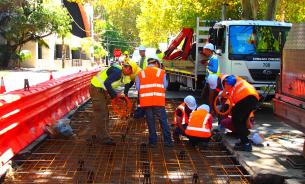Current processes for lightweight aggregates production using sintered fly ash are carbon intensive. Geopolymer concrete produced from industrial by-products fly-ash and slag has an 80 per cent lower carbon footprint compared to the conventional Portland cement concrete, which has a carbon footprint second only to fossil fuels. Lightweight concrete with superior insulation properties can potentially reduce energy use in buildings, also reducing carbon.
This project aims to reduce the commercial barriers to new low-carbon construction materials by:
- Gathering field data of real-life geopolymer constructions to develop confidence in its use.
- Developing a handbook for use in design, specifying and construction.
- Undertaking a pilot program for producing lightweight concrete using low carbon processes based on geopolymerisation and alternative methods for producing aggregates from fly-ash.
The project will deliver to infrastructure designers an Australian standard (or any other standards) that they can use for designing structures with geopolymer concretes. Validation and adaption of appropriate test methods according to the standards to allow for the commercial use of synthetic aggregates.
Details of the next phase of this research are here.

